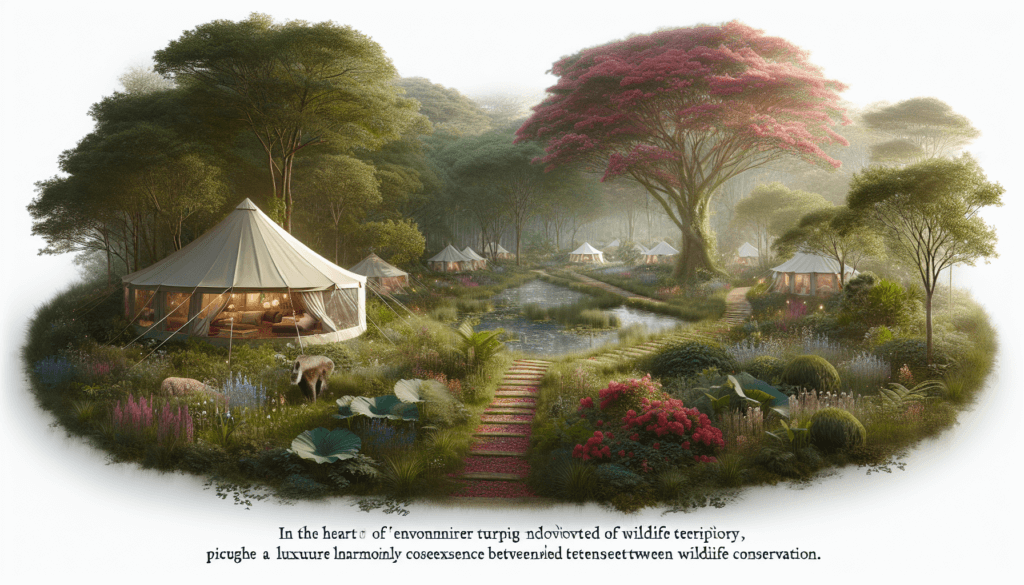Imagine escaping the hustle and bustle of modern life and immersing yourself in the serenity of nature, all while helping to preserve wildlife and their habitats. This article explores the best ways to create a glamping retreat that not only offers luxurious accommodations but also promotes wildlife conservation and appreciation. From eco-friendly practices to providing educational experiences, discover how you can create an unforgettable experience for nature enthusiasts while contributing to the well-being of our planet’s magnificent creatures.

Design and Location
Choosing the Right Location
When it comes to creating a glamping retreat for wildlife conservation and appreciation, choosing the right location is crucial. Look for a site that is nestled within a natural habitat, surrounded by diverse flora and fauna. Ideally, the location should have a balance of scenic beauty and wildlife richness. Conduct thorough research to ensure that the chosen spot is free from any potential harm to wildlife and their habitats.
Designing Eco-friendly Structures
To ensure minimal impact on the environment, it is important to design eco-friendly structures for the glamping retreat. Opt for sustainable building materials such as bamboo or reclaimed wood, and incorporate energy-efficient technologies like solar panels for electricity generation. Furthermore, use natural ventilation and lighting systems to reduce the reliance on artificial resources. By adopting such practices, you can create a sustainable haven that harmoniously blends with the surrounding nature.
Creating Natural Habitats
One of the key goals of a glamping retreat for wildlife conservation and appreciation is to provide a safe haven for native wildlife. Design the retreat in a way that encourages the development of natural habitats. Include features like birdhouses, bat boxes, and ponds to attract and support local wildlife. By creating these natural habitats, you not only provide a welcoming environment for wildlife but also offer guests an opportunity to witness and appreciate the wonders of nature up close.
Sustainable Practices
Using Renewable Energy Sources
To minimize the ecological footprint of the glamping retreat, it is essential to utilize renewable energy sources. Install solar panels or small wind turbines to generate electricity for the retreat. This will not only reduce carbon emissions but also inspire guests to adopt sustainable practices in their daily lives. Additionally, consider implementing energy-saving measures such as LED lighting and smart energy management systems to further enhance the retreat’s energy efficiency.
Implementing Water Conservation Strategies
Water conservation is a vital aspect of sustainable practices. Incorporate water-saving technologies like low-flow fixtures and rainwater harvesting systems to reduce the retreat’s water consumption. Encourage guests to participate in water conservation efforts by providing them with information about the importance of responsible water usage. By practicing water conservation, you not only contribute to the preservation of the local ecosystem but also set an example for others to follow.
Promoting Sustainable Agriculture
Supporting sustainable agriculture can have a positive impact on both the environment and local communities. Consider establishing organic gardens or partnering with local farmers who follow sustainable farming practices. This will not only provide fresh and organic produce for the retreat’s guests but also support local agriculture and reduce the carbon footprint associated with food transportation. Additionally, educate guests about the benefits of sustainable agriculture and inspire them to make conscious choices when it comes to their own food consumption.

Wildlife Education and Appreciation
Offering Guided Nature Tours
A glamping retreat for wildlife conservation and appreciation should provide guests with the opportunity to immerse themselves in the natural wonders of the surrounding area. Offer guided nature tours led by knowledgeable experts who can educate guests about the local flora and fauna. These tours can include activities such as bird watching, nature hikes, and wildlife spotting. By offering these experiences, guests can develop a deeper appreciation for the wildlife and habitats while learning about the importance of conservation.
Organizing Educational Workshops
Education plays a crucial role in wildlife conservation. Organize educational workshops where guests can learn about various conservation initiatives, environmental challenges, and sustainable practices. These workshops can cover topics such as wildlife protection, habitat restoration, and climate change. By providing guests with a platform to gain knowledge and engage in meaningful discussions, the glamping retreat can empower individuals to make a positive impact on the environment.
Providing Wildlife Viewing Opportunities
One of the highlights of a glamping retreat focused on wildlife conservation is the opportunity to observe wildlife in their natural habitats. Create designated wildlife viewing areas or install strategically placed observation decks that provide guests with a safe and non-intrusive way to witness the beauty of wildlife. Ensure that these areas are designed to maintain a respectful distance from wildlife, minimizing any potential disturbances. By providing these opportunities, guests can develop a deeper connection with nature and gain a greater understanding of the importance of wildlife conservation.
Engaging the Local Community
Collaborating with Local Conservation Organizations
Building strong relationships with local conservation organizations is essential for the success of a glamping retreat focused on wildlife conservation. Collaborate with these organizations to develop conservation initiatives, share resources, and support each other’s efforts. By working together, you can amplify the impact of conservation projects and foster a sense of community among like-minded individuals and organizations.
Supporting Local Indigenous Communities
Engaging with and supporting local indigenous communities is an important aspect of a responsible glamping retreat. Recognize and respect the indigenous people’s deep connections to the land and wildlife and seek their guidance in implementing conservation practices. In addition to providing economic opportunities and representation, supporting local indigenous communities can ensure that cultural heritage and traditional knowledge are preserved and celebrated.
Hosting Community Events
To foster a sense of community and promote environmental awareness, host community events at the glamping retreat. Organize clean-up drives, tree-planting activities, and environmental awareness campaigns in collaboration with local schools, organizations, and residents. These events not only contribute to the preservation of the local ecosystem but also create a platform for knowledge-sharing and inspire others to take action towards wildlife conservation.

Preservation and Restoration Efforts
Restoring Native Vegetation
Native vegetation plays a crucial role in maintaining biodiversity and providing habitats for wildlife. Undertake restoration efforts to reintroduce native plant species in the surrounding area. This can involve removing invasive species, planting native trees and shrubs, and restoring natural water bodies. By restoring native vegetation, you create a thriving ecosystem that supports a diverse range of wildlife.
Protecting Endangered Species
Focus on protecting and conserving endangered species that may inhabit the vicinity of the glamping retreat. Collaborate with local wildlife authorities and conservation organizations to develop and implement strategies for the protection and preservation of these species. This can include habitat restoration, the establishment of protected zones, and monitoring programs. By actively working towards protecting endangered species, the glamping retreat can contribute to the overall conservation efforts in the region.
Implementing Waste Management Systems
Proper waste management is vital for maintaining the ecological integrity of the glamping retreat and its surrounding areas. Implement waste management systems that prioritize recycling, composting, and minimal waste generation. Provide guests with clear guidelines on responsible waste disposal and encourage them to participate in waste reduction initiatives. By adopting sustainable waste management practices, the glamping retreat can ensure the long-term preservation of the local ecosystem.
Safety and Security Measures
Ensuring Wildlife-Friendly Practices
Safety measures should be implemented to ensure that wildlife is not harmed or disturbed by the activities of the glamping retreat. Establish protocols and guidelines for guests to follow, emphasizing the importance of respecting wildlife and their habitats. Train staff members to handle wildlife encounters responsibly and provide education to guests about wildlife behavior and safety. By prioritizing wildlife-friendly practices, the glamping retreat can maintain a harmonious relationship with the local ecosystem while promoting responsible tourism.
Providing Emergency Response Plans
To ensure the safety of both guests and wildlife, it is crucial to have well-defined emergency response plans in place. Train staff members on emergency procedures and establish communication channels with local authorities and emergency services. Conduct regular drills and simulations to ensure that everyone is prepared to handle any emergency situations that may arise. By prioritizing safety, the glamping retreat can provide a secure environment for guests while minimizing the impact on wildlife.
Maintaining Visitor Safety Standards
In addition to wildlife safety, it is important to maintain visitor safety standards at the glamping retreat. Conduct regular safety inspections to identify and address any potential hazards. Install safety features such as proper lighting, handrails, and emergency contact information at strategic locations. Educate guests about safety protocols and provide them with necessary equipment for outdoor activities. By prioritizing visitor safety, the glamping retreat can ensure a positive and secure experience for all.

Promotion and Marketing
Creating Engaging Website and Social Media Profiles
Having a strong online presence is essential for promoting a glamping retreat focused on wildlife conservation and appreciation. Create an engaging website and social media profiles that highlight the unique experiences and sustainable practices offered at the retreat. Use visually appealing images and informative content to captivate potential guests and inspire them to visit. Share stories and educational content about wildlife conservation to further engage and educate your audience.
Partnering with Travel Blogs and Influencers
Collaborating with travel blogs and influencers can help increase awareness and reach a broader audience. Identify influencers and bloggers who align with the values and goals of the glamping retreat and invite them to experience and share their journey. Encourage them to promote the conservation efforts and sustainable practices implemented at the retreat. By leveraging the reach and influence of these individuals, the glamping retreat can attract environmentally conscious travelers who are passionate about wildlife conservation.
Offering Special Packages and Discounts
To incentivize guests to choose the glamping retreat for their wildlife conservation experience, offer special packages and discounts. Design packages that include guided nature tours, educational workshops, and immersive wildlife experiences. Provide discounts for guests who choose to stay longer or come during off-peak seasons. By offering attractive packages and discounts, the glamping retreat can encourage more people to visit and actively participate in wildlife conservation efforts.
Collaboration with Scientists and Researchers
Supporting Wildlife Research Projects
Collaborating with scientists and researchers can contribute significantly to the understanding and conservation of local wildlife. Provide support for ongoing research projects by granting access to the retreat’s grounds, collecting data, or offering logistical assistance. By supporting wildlife research, the glamping retreat can contribute to the scientific community’s knowledge and help shape conservation strategies for the long-term protection of wildlife.
Encouraging Citizen Science Participation
Engage guests in citizen science initiatives to involve them directly in wildlife conservation efforts. Encourage them to participate in data collection, biodiversity monitoring programs, or assist in ongoing research projects. By involving guests in such initiatives, the glamping retreat not only enhances their experience but also fosters a sense of stewardship and encourages active involvement in wildlife conservation even after their visit.
Hosting Scientific Conferences
Offer the glamping retreat as a venue for scientific conferences and seminars focused on wildlife conservation. Invite researchers, scientists, and conservationists from around the world to share their findings, discuss challenges, and collaborate on conservation strategies. By hosting such events, the glamping retreat can become a hub for knowledge exchange and contribute to advancing wildlife conservation on a global scale.

Partnerships and Sponsorships
Forming Collaborative Relationships with Environmental Organizations
Forming collaborative relationships with environmental organizations can strengthen the impact of the glamping retreat’s conservation efforts. Partner with organizations that share the same goals and values to develop joint initiatives, share resources, and expand outreach. By joining forces, the glamping retreat and environmental organizations can amplify their efforts to protect wildlife and preserve the natural environment.
Seeking Sponsorships from Wildlife Conservation Initiatives
Seeking sponsorships from wildlife conservation initiatives can provide essential financial support for the glamping retreat’s conservation projects. Reach out to foundations, grants, and organizations that fund wildlife conservation initiatives and explain how the glamping retreat aligns with their objectives. Present a compelling case for how their sponsorship can contribute to the conservation efforts and the overall protection of wildlife.
Establishing Partnerships with Sustainable Brands
Partnering with sustainable brands can promote the glamping retreat’s commitment to sustainable practices and wildlife conservation. Collaborate with brands that offer eco-friendly products or services and showcase them at the retreat. Establish a mutual promotion strategy to raise awareness about both the glamping retreat and the sustainable brands. By forming partnerships with sustainable brands, the glamping retreat can expand its reach and inspire guests to make responsible choices in their everyday lives.
Monitoring and Evaluation
Tracking Wildlife Populations and Behaviors
Regular monitoring and tracking of wildlife populations and behaviors are crucial for understanding the impact of conservation efforts. Collaborate with local wildlife experts and researchers to establish monitoring programs that collect data on species abundance, distribution, and behavior. Use modern techniques like camera traps, remote sensing, and bioacoustics to gather accurate information. By monitoring wildlife populations and behaviors, the glamping retreat can make informed decisions and adjust conservation strategies accordingly.
Assessing Conservation Impact on the Surrounding Ecosystem
Evaluate the impact of conservation efforts on the surrounding ecosystem to ensure their effectiveness. Conduct regular assessments to measure changes in habitat quality, biodiversity, and ecosystem health. Analyze data collected from monitoring programs and compare it with pre-established benchmarks. By assessing conservation impact, the glamping retreat can identify areas of improvement and adapt their practices to achieve maximum conservation outcomes.
Regular Evaluation of Sustainable Practices
Continuously evaluate the effectiveness of sustainable practices implemented at the glamping retreat. Monitor energy and water consumption, waste generation, and resource usage to identify areas where improvements can be made. Seek guest feedback through surveys or comment cards to gain insights into their perceptions and suggestions for further sustainability enhancements. By regularly evaluating sustainable practices, the glamping retreat can ensure that it stays on track towards its conservation and sustainability goals.


